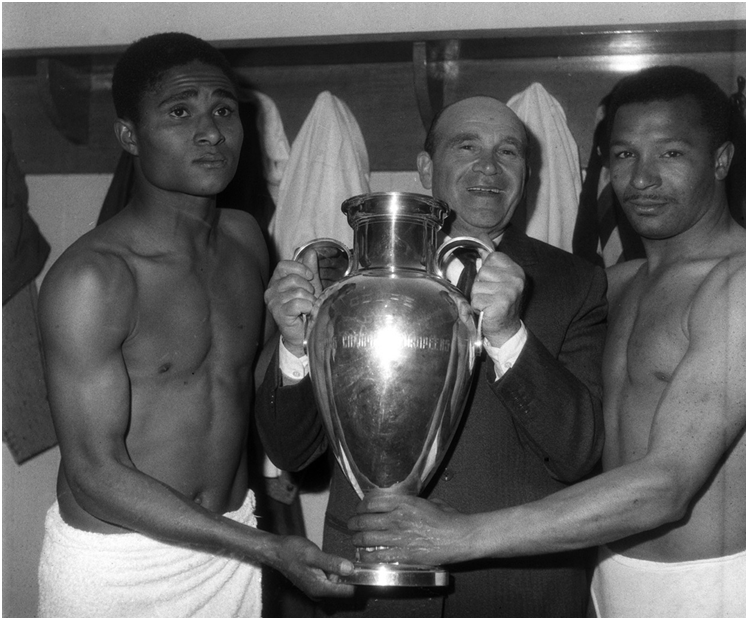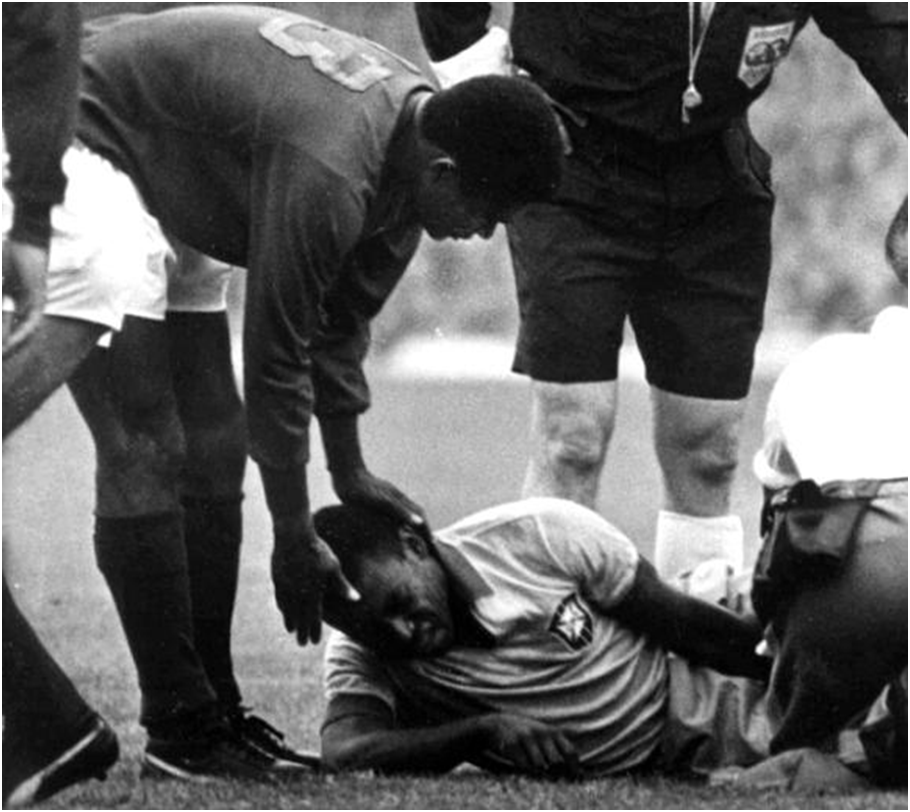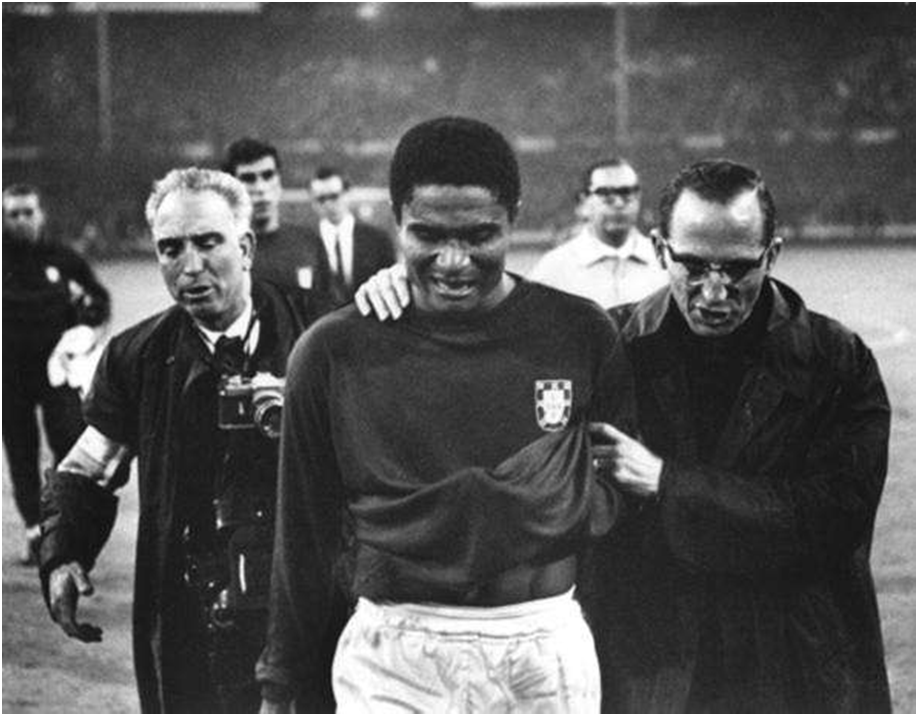The Legend of Ruth Malosso
“He was not only a great inspiration but also an important figure in upholding the values, principles and feelings of football, even after finishing his career,” says Chelsea manager, José Mourinho. Srinwantu Dey tries to pay a humble tribute to the immortal ‘O Rei’, a wonderful soul and modest ambassador for both Portuguese football and Benfica. An extended version of this article has been published in ‘Tiro: A football odyssey from Amazon to Alps’ , Rattis Books, UK, June 2016.
In one of football’s most recognizable traditions, live bald eagles swoop around the 65,000 odd crowd before every game at one of Portugal’s “Big Three” as mascots – Vitória and Glória (Victory and Glory). It’s a sad day for football lovers as Portugal and Benfica legend Eusébio leaves for his heavenly abode, leaving millions in grief, following a heart attack earlier today. His legacy can never fade into oblivion as long as ‘Victory’ and ‘Glory’ keep entertaining us – symbols befittingly synonymous to The Black Pearl. Penning a tribute piece on this legend is a Herculean task I believe, as his stature, statistics and accolades are far too astonishing to translate into words. Let us instead look through a few incidents from the early years of his career, which announced to the world in the 60’s – a legend has arrived to rule Europe!

The Myth of Ruth Malosso
Eusébio was born to a poverty-stricken family in Portuguese East Africa (now Mozambique). Football was more than a game to him and he was often found playing on the streets instead of attending school. As a result, he was the only member of his family who couldn’t finish schooling. He was an amazing talent since his childhood and no wonder he caught the eyes of several talent scouts. The scenario at Mozambique was very different back then – it was a Portuguese colony and there was no professional setup for playing football. The better clubs were actually feeder clubs of famous football clubs of Portugal. Eusébio was picked up by a local club – Sporting Clube de Lourenço Marques which had a tie-up with the very famous Sporting Clube de Portugal, Lisbon.
Being a subsidiary of big clubs of Portugal, often they used to get a chance to play against big guns of Portugal and other top clubs during their African tours. Such a tour of ‘Clube de Futebol Os Belenenses’ (current Portuguese Cup winners, 1960) discovered a young 17-year old boy who scored two goals against them with blistering pace. Former Brazilian international, José Carlos Bauer was the first person to notice his immense ability who was travelling to Mozambique at the same time with his São Paulo based club Ferroviária de Araraquara. Surprised by his skill level, Bauer immediately referred him to São Paulo, but the Brazilian club denied the chance to take risks for an unknown African footballer. There is a myth that after returning to his home town, Bauer went to a hair-cutting salon where he came across his old acquaintance Béla Guttmann. Guttmann, a Jewish-Hungarian, who was a former manager of São Paulo – was managing S.L. Benfica at the time. During a friendly conversation, Bauer mentioned to him about this young talent of Southeast Africa.

Guttmann was known to be a gold digger. He had just sacked 20 senior players after taking charge of Benfica and was looking for fresh faces. He enquired about Eusébio and came to know about his fascinating skills. He also learnt that Eusébio is currently playing for their biggest rival’s feeder club. At the same time, slow movements had started at other side of Lisbon when Eusébio’s childhood friend Hilário da Conceição – who already was an established defender of Sporting Lisbon – had recommended him to his club. Guttmann didn’t take any chances as he knew it was easier for Sporting to capture this raw talent as he was playing for their subsidiary club. This being a highly sensitive issue, the Benfica board decided that they will never use Eusébio’s name in any communication before the deal finalizes, and thus given a code name – Ruth Malosso. Guttmann went straight to Eusébio’s family home and convinced both him and his mother for this move and got him to sign a contract. He was brought to Portugal secretly after that in December 1960, and sent to the outskirts of Lisbon to prevent any kidnapping. After a long running tug-of-war between two rival clubs, it was agreed upon that Eusébio will be playing for Benfica and he was registered in May, 1961.
After seeing Eusébio train for the first time at the Estadio da Luz, Guttmann shouted to his assistant Fernando Caiado, “It is gold. It is gold”. José Aguas, Benfica’s #9 and captain, promptly suggested “If it has to be me then so be it, but somebody has to drop out for him to play.” And the rest was history.
‘Eusébio 3-2 Pelé’
Just after Eusébio started displaying his charisma in Portugal, Benfica were invited to play in the Tornio International de Paris in 1961 and in the final they played against an exceptional Santos side, led by the ‘best in planet’ footballer Pelé. Within an hour, Benfica found themselves trailing by an insulting 5-0 scoreline, where Pelé struck twice. Guttman had to unleash his last weapon, codename Malosso, from the reserve. He was not mistaken. The 18-year old substitute scored a rapid hat-trick within 63rd to 80th minute of the match. He also won a penalty, which his teammate failed to converted. Guttmann’s young team eventually lost the tie 6-3 to a star-studded Santos team, but the young prodigy won everybody’s heart on that day. Next day, prestigious French magazine L’Équipe made a headline neglecting the main scoreline and Santos’ victory which read as ‘Eusébio 3-2 Pelé’. Later, Pelé stated about Eusébio – “He scored beautiful goals. All of the Santos players, including myself, thought Eusébio was a great player even if none of us knew who he was at that time.” After this encounter, they met quite a few times, but this game truly announced that another black pearl has come to rule the world.

Taking on the Galácticos
A crowd of over 60,000 gathered in Amsterdam’s Olympic Stadium hoping to witness a clash of the titans at 1962 European Cup final between Real Madrid and Benfica. This was a game where Real was trying to re-establish their dominance on European kingdom, and reigning champions Benfica were establishing themselves as an unstoppable force in the Europian mainland. Eusébio was there too. But he was more mesmerized to play against his childhood hero – Alfredo Di Stéfano. The classic final started and soon Di Stéfano took over control of the midfield playing from the deep, while razor-sharp Ferenc Puskás kept threatening the Benfica defence continuously. Within 25 minutes, the Hungarian wizard put Madrid upfront with a two-goal lead. Though Benfica equalized the score, but again before half time, Puskás completed his hat-trick and gave Madrid back the lead. In the second half, Guttmann was able to shut down Madrid’s mastermind Di Stéfano’s elegance and that is when the ‘Black Panther’ took over control of the stage. Once Mário Coluna made it 3-3, Eusébio scored two goals within 5 minutes, and eventually, Benfica was the winner with a thumping 5-3 scoreline. But Eusébio didn’t forget his dream, he collected the shirt of the Argentine genius and kept it hidden underneath his shorts so that nobody can steal it from him – it was pretty precious to him. The scene was symbolic, as it depicted the passing of legacy from one legend to another. Eusébio definitely didn’t disappoint Di Stéfano!

The Legacy
In his decorated career, he kept scoring goals and making history for Benfica and Portugal. Numbers do the talking for him. One may browse the digital media to find countless lists of his achievements. For me he was a legend true to his own style – a perfect striker with blistering speed, silky skills and enormous power! Guttmann aptly described his shots like watching Sputnik launch into space!
His arrival in Europe was definitely not the first among Africans. Even before him, Maghrebi star player Larbi Ben Barek or Sebastião Lucas de Fonseca of Maputo – who was known as the eighth wonder of theworld among Portuguese – already pioneered that Africans also can contribute to European football. But Eusébio was definitely the first imported African who ruled the European football demography for more than a decade. The floodgate was opened by him, leading to European powerhouses starting thorough scouting in their colonized provinces. He couldn’t play for his own country Mozambique. Mozambique football association wasn’t established until 1976, after they earned their sovereignty the preceding year. From early 60’s, Portugal regime was involved in turmoil, insurgencies and other political pressure. Rather his inclusion and glorious performance for the Portuguese national team helped the regime to highlight the unity of the metropole and the colonies, leading to racial harmony. His nickname given as ‘O Rei’ (The King) had massive significance in a regime of fascist dictators.

Being a thorough gentleman and great ambassador of the game, Eusébio won the hearts of all his compatriots and opponents. During the ‘Game of Tears’ where Portugal lost to England 2-1 at Wembley and were knocked out of the 1966 World Cup, Eusébio was found to break down in tears and comforted to the dressing room by both team-mates and opponents. Truly, the greatest victory ever for Benfica over Sporting Lisbon has been nothing but winning Eusébio from them.
Rest in peace, Panther.